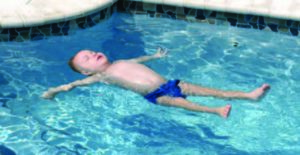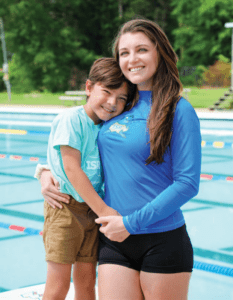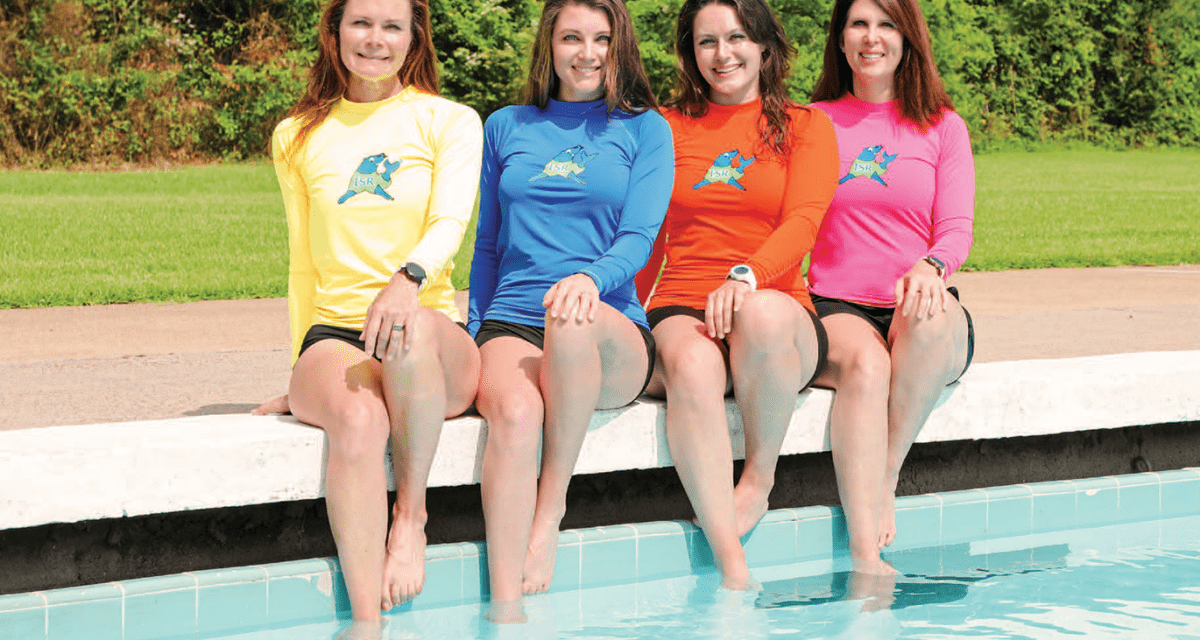[vc_row][vc_column][vc_column_text]
Teaching Children
Water Survival Skills
By- Elizabeth Deal
[/vc_column_text][vc_column_text]
It can take less than a minute for a child to drown.
Preliminary data from the Louisiana Department of Health (LDH) shows that 25 infants and children died from drowning in 2021. Between 2017-19, drowning was the third leading cause of injury-related death in Louisiana children (0-14) with top risk factors being child unable to swim (96%), not supervised (72%) and no barriers to water (54%).
Extremely passionate about teaching water survival skills are Tara Hardin, Emma Burnett, Ashton Hardin, and Hallie Horne of ISR ArkLaTex. They are instructors certified through Infant Swim Resource (ISR),a national organization founded in 1966 by Dr. Harvey Barnett. The goal of ISR is to teach safety and survival. At a minimum, a child will learn to roll onto his or her back to float, rest, and breathe, and to maintain this position until help arrives. Children as young as six months can learn to save themselves. According to the ISR website, the ISR Self-Rescue® instruction for students is the product of over 45 years of research and achieves unparalleled results.
Tara is the mother of Emma and Ashton, and Hallie is her close friend. They are part of over 300,000 ISR graduates, and they are also CPR certified.
ISR has over 800 documented survival stories, one which hits very close to home. Emma’s own son, Eddie, is proof that the ISR survival skills work. As a toddler, having already completed the ISR course, Eddie fell into a body of water adjacent to a pool. No one was aware that a grate covering had not been replaced after the daily maintenance of the pool. Fortunately, Eddie was found inside—floating on his back—just as he had learned.
The ISR program emphasizes that competence leads to confidence. “Once they become competent and know what they’re doing, we see the love of the water come,” says Emma. There are programs that teach kids to enjoy the water first before learning any skills, but she thinks that may be dangerous. A child might be drawn to the water even more without having any skills. The ISR instructors encourage the kids to become skilled first, and then they encourage them to use the skills to have fun. They are survival skills, but they can be used for recreational swimming as well.
To become a certified ISR instructor, individuals undergo two weeks of academic training and six weeks of in-water training, conducted by a master instructor.
ISR lessons are one-on-one for 10 minutes a day, five days a week, and last about four to six weeks. The child works with the same ISR instructor every day, so they pick up right where they left off the day before. “We teach the short, frequent lessons because that’s how kids learn. When we watch our kids learning how to crawl or learning how to walk, we don’t see them practicing it for 30 minutes once a week. We see them doing it every day, little, short spurts of practice. So, we’re meeting them with what their attention spans are able to handle. It’s physically challenging and a lot of work, so 10 minutes is enough,” Emma explains. “Initially, we see kids are nervous. They’re not very comfortable in the beginning of lessons. We’re asking them to do so many new things in a short amount of time. But our job and what we get trained to do is to break those skills down in a way that meets each child’s needs where they are.And in that way, it’s a really gentle method. As they master those skills, we’re constantly moving on to the next thing.”
 ISR instructors aren’t completely on their own. They are supported with a host of resources through the national organization. Nurses have set medical protocols around placing the children in the water, taking them out, and the length of time that it’s safe to be underwater, so there’s guesswork. Instructors can reach out to master instructors with questions. “If we’re having an especially difficult time with a child, we can take a video and send it in, and they’ll let us know if there’s anything within the lesson we can do to make the progress we’re promising. There’s no cookie cutter way to do this—you know they’re all different,” says Emma.
ISR instructors aren’t completely on their own. They are supported with a host of resources through the national organization. Nurses have set medical protocols around placing the children in the water, taking them out, and the length of time that it’s safe to be underwater, so there’s guesswork. Instructors can reach out to master instructors with questions. “If we’re having an especially difficult time with a child, we can take a video and send it in, and they’ll let us know if there’s anything within the lesson we can do to make the progress we’re promising. There’s no cookie cutter way to do this—you know they’re all different,” says Emma.
Students can be as young as six months, but they must meet certain developmental milestones first. They need to be able to sit up unassisted. It helps if they can roll back to belly and belly to back. Crawling isn’t required but is beneficial to learn how to roll and float.
Emma offers advice for parents choosing a swim lesson. “I want people to know what to look out for that can help them choose the right kind of lessons for their kid, whether it’s with us or somebody else. Look for those lessons that the instructor is helping them learn how to hold their breath immediately. Not blowing bubbles but holding their breath. Learning how to float and rest and breathe. Learning how to go into the water and get to the edge swimming horizontally, eyes down, kicking a little, using their arms a little. Holding their breath about three seconds is a good amount of time before they need a breath.”
One of their primary teaching locations is Southside Swim Club, where Tara Hardin is the head coach for both the High School/ Middle School Swim program and the Flying Fish Summer Swim Team. They teach traditional lessons for beginner/intermediate/ advanced swimmers in addition to ISR survival skills there. “Here at Southside, we are providing the programs that see our students through from when they are babies who need to learn how to self-rescue all the way up through swim team! We work to get our young students safe first and then show them how to use their survival skills to have fun in the water and eventually be able to compete,” says Hardin.
ISR believes pool fences, supervision, and pool alarms are important parts of a necessary multi-layered approach to drowning prevention, but the core conviction is that the child is the most important part of a drowning prevention strategy.
“Learning to swim is within us. We teach survival first,” says Emma.
Find a Certified ISR Instructor at swim.com. Search “Instructor Locator.” You will find this group in Shreveport, Bossier, and Minden. In Benton, you will find instructor Courtney Haas.
[/vc_column_text][/vc_column][/vc_row]









